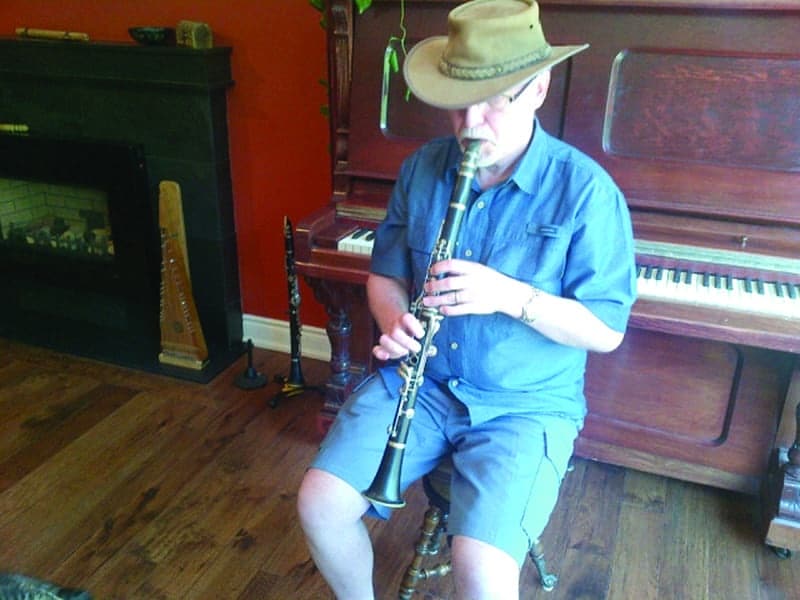Back to Basics | July 2015 Hearing Review
This is a common question that I am asked, and without further hesitation (since I have kept you waiting long enough), the answer is not as complex as you may think it is.
And the answer is…the clarinet.
I should point out that I am biased and play this instrument myself (see photo). My music teacher assures me that I am good enough to play in a community band. I am not sure whether this is a compliment or an insult.
Having dispensed with my potential conflict-of-interest statement, a musical instrument that has most of its energy in the lower frequency region, has most of its auditory cues in the lower frequency region, and provides more than one cue to its playing level, would be ideal for anyone who has relatively good low frequency hearing acuity but poorer (if any) hearing acuity in the higher frequency region. In short, the clarinet would be ideal for those with a mild hearing loss, a moderate hearing loss, and a high frequency sloping hearing loss.
More Support (Other Than Author’s Preference)
The clarinet functions as a quarter-wave-length resonator for the lower registers (up to about the middle of the treble clef) and then functions as a half-wavelength resonator for everything above that. In common English, this means that where a person may have relatively good hearing (ie, in the lower bass notes) there are harmonics at odd-numbered multiples of the fundamental (or note name), but where a person may have greater difficulty hearing (ie, in the higher pitched treble notes), there will be twice as many harmonic cues—there are integer multiples of the fundamental or note name. The clarinet provides “enough” cues where needed for the lower register and an enriched number of cues where a hard-of-hearing person may require “a bit more” help.
In addition to the acoustics mentioned above, there is an interesting perceptual feature that all woodwinds share. This is true of the clarinet, but also the oboe, saxophone, and bassoon as well. Although the clarinet can generate a wide spectrum of sound, not unlike a violin, to be able to play and appreciate the clarinet, only the lower frequency sounds are required. One can filter or chop off all of the higher frequency components of the clarinet and it would still sound the same. In musical parlance, a woodwind player is interested in hearing the lower frequency inter-resonant breathiness and tone, and as long as the lower frequency sounds are audible, that would be enough.
In contrast, a string instrument, such as a violin, has a much more broadband perceptive requirement. One needs to be able to hear the balance between the lower frequency fundamental energy and the higher frequency harmonic energy. In part, it is this balance that defines a Stradivarius and distinguishes it from a student model violin. A clarinet player only needs to hear the low end notes, despite being able to generate the higher frequency harmonics.
This also has ramifications for the selection of hearing aids. If a hard-of-hearing person chooses to play the clarinet, a “run of the mill” hearing aid that has been optimized for speech, replete with multi-band compression, should be fine. The same cannot be said of a hearing aid for string-heavy music, such as classical music. To be able to hear and appreciate string-heavy music, an optimal hearing aid should have a single channel—something that the hearing aid industry no longer has—and a topic covered in my May 2015 column. (Author’s note: I should mention that the single-channel K-AMP analog hearing aid is still commer- cially available for adults from sources such as www.generalhearing.com.)
As the playing level gets louder, the level of the fundamental doesn’t increase that much; it is the higher frequency harmonics that significantly increase in magnitude. This is true for all woodwind musical instruments. While it’s true that a hard-of-hearing person may not be able to hear this high frequency information, luckily a loudness cue can also be found with the tension or embouchure of the lips, as well as the sensation of lung pressure. This multi- cue aspect of loudness makes a reeded instrument such as the clarinet even better for people with hearing impairment.
And there is yet another important reason why you should recommend your child to play the clarinet: it’s light to carry! Imagine a 7-year-old walking home from school lugging a 300-lb cello.
Marshall Chasin, AuD, is an audiologist and director of research at the Musicians’ Clinics of Canada, Toronto. He has authored five books, including Hearing Loss in Musicians, The CIC Handbook, and Noise Control—A Primer, and serves on the editorial advisory board of HR. Dr Chasin has guest-edited three special editions of HR on music and hearing loss (August 2014, March 2006, and February 2009), as well as a special edition on hearing conservation (March 2008).
Correspondence can be addressed to: [email protected]
Original citation for this article: Chasin, M. Back to Basics: What Is the Best Musical Instrument for My Child Who Is Hard of Hearing? Hearing Review. 2015;22(7):14.?







